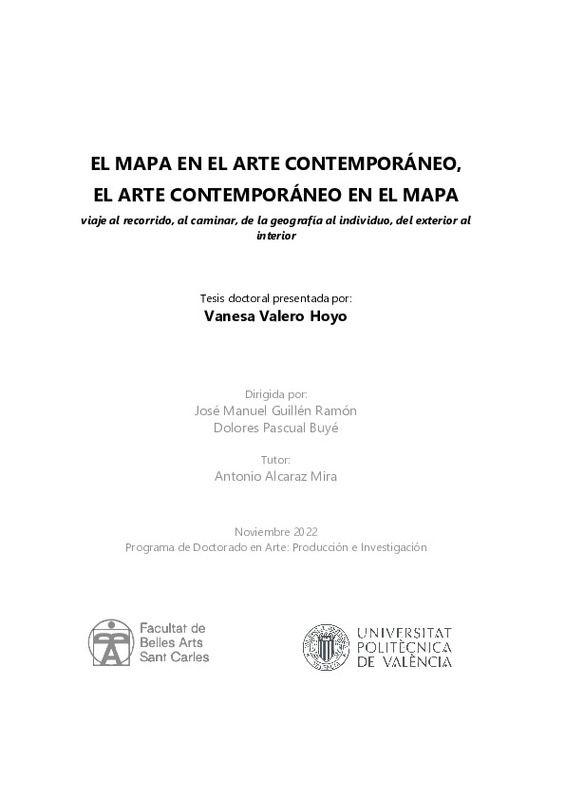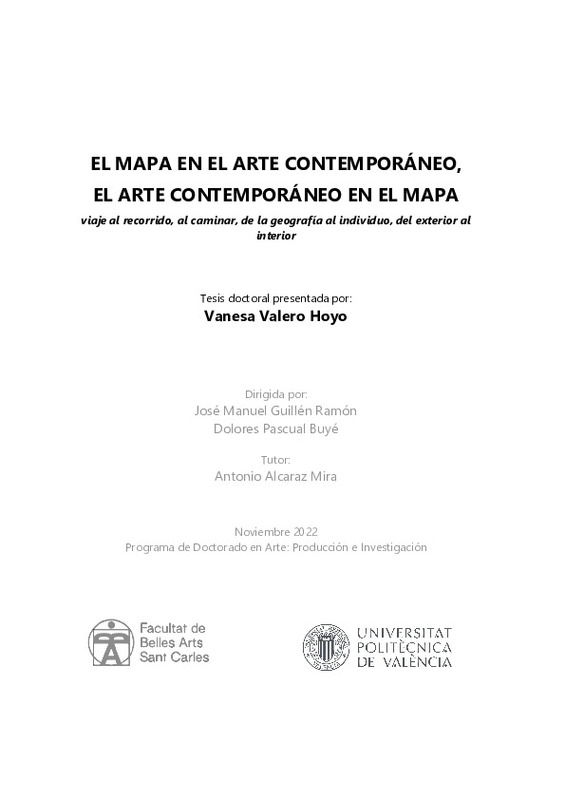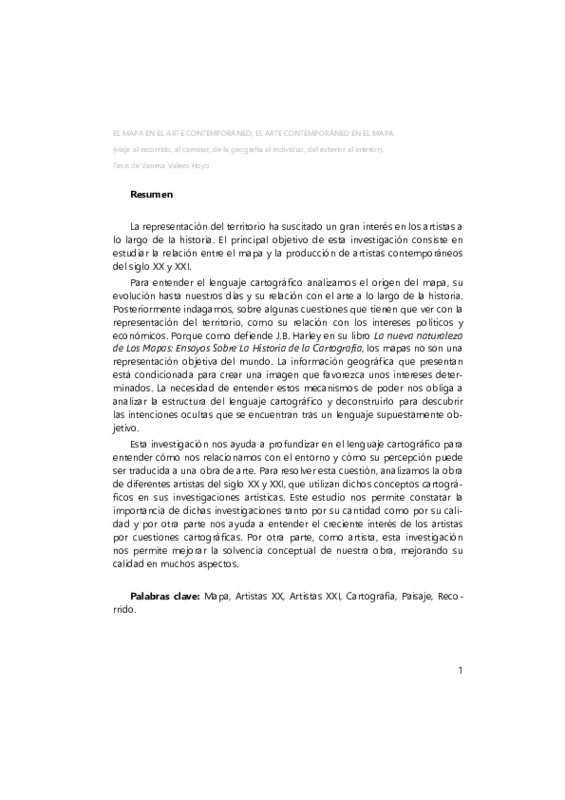- RiuNet repositorio UPV
- :
- Investigación
- :
- Tesis doctorales
- :
- Ver ítem
JavaScript is disabled for your browser. Some features of this site may not work without it.
Buscar en RiuNet
Listar
Mi cuenta
Estadísticas
Ayuda RiuNet
Admin. UPV
El mapa en el arte contemporáneo, el arte contemporáneo en el mapa. (Viaje al recorrido, al caminar, de la geografía al individuo, del exterior al interior)
Mostrar el registro sencillo del ítem
Ficheros en el ítem
| dc.contributor.advisor | Guillén Ramón, José Manuel
|
es_ES |
| dc.contributor.advisor | Pascual Buyé, María Dolores
|
es_ES |
| dc.contributor.author | Valero Hoyo, Vanesa
|
es_ES |
| dc.date.accessioned | 2023-03-06T08:26:31Z | |
| dc.date.available | 2023-03-06T08:26:31Z | |
| dc.date.created | 2023-02-01 | |
| dc.date.issued | 2023-03-06 | es_ES |
| dc.identifier.uri | http://hdl.handle.net/10251/192299 | |
| dc.description.abstract | [ES] La representación del territorio ha suscitado un gran interés en los artistas a lo largo de la historia. El principal objetivo de esta investigación consiste en estudiar la relación entre el mapa y la producción de artistas contemporáneos del siglo XX y XXI. Para entender el lenguaje cartográfico analizamos el origen del mapa, su evolución hasta nuestros días y su relación con el arte a lo largo de la historia. Posteriormente indagamos, sobre algunas cuestiones que tienen que ver con la representación del territorio, como su relación con los intereses políticos y económicos. Porque como defiende J.B. Harley en su libro La nueva naturaleza de Los Mapas: Ensayos Sobre La Historia de la Cartografía, los mapas no son una representación objetiva del mundo. La información geográfica que presentan está condicionada para crear una imagen que favorezca unos intereses determinados. La necesidad de entender estos mecanismos de poder nos obliga a analizar la estructura del lenguaje cartográfico y deconstruirlo para descubrir las intenciones ocultas que se encuentran tras un lenguaje su-puestamente objetivo. Esta investigación nos ayuda a profundizar en el lenguaje cartográfico para entender cómo nos relacionamos con el entorno y cómo su percepción puede ser traducida a una obra de arte. Para resolver esta cuestión, analizamos la obra de diferentes artistas del siglo XX y XXI, que utilizan dichos conceptos cartográficos en sus investigaciones artísticas. Este estudio nos permite constatar la importancia de dichas investigaciones tanto por su cantidad como por su calidad y por otra parte nos ayuda a entender el creciente interés de los artistas por cuestiones cartográficas. Por otra parte, como artista, esta investigación nos permite mejorar la solvencia conceptual de nuestra obra, mejorando su calidad en muchos aspectos. | es_ES |
| dc.description.abstract | [CA] La representació del territori ha suscitat un gran interès en els artistes al llarg de la història. El principal objectiu d'aquesta investigació consisteix a estudiar la relació entre el mapa i la producció d'artistes contemporanis del segle XX i XXI. Per a entendre el llenguatge cartogràfic analitzem l'origen del mapa, la seua evolució fins als nostres dies i la seua relació amb l'art al llarg de la història. Posteriorment indaguem, a un nivell teòric, algunes qüestions que te-nen a veure amb la representació del territori, com la seua relació amb els interessos polítics i econòmics. Perquè com defensa J.B. Harley en el seu llibre, La nova naturalesa dels Mapes: Assajos Sobre La Història de la Cartografia, els mapes no són una representació objectiva del món. La informació geogràfica que presenten està condicionada per a crear una imatge que afavorisca uns interessos determinats. La necessitat d'entendre aquests mecanismes de poder ens obliga a analitzar l'estructura del llenguatge cartogràfic i desconstruirlo per a descobrir les intencions ocultes que es troben després d'un llenguatge suposadament objectiu. Aquesta investigació ens ajuda a aprofundir en el llenguatge cartogràfic per a entendre com ens relacionem amb l'entorn i com la seua percepció pot ser traduïda a una obra d'art. Per a resoldre aquesta qüestió, analitzem l'obra de diferents artistes del segle XX i XXI, que utilitzen aquests conceptes cartogràfics en les seues investigacions artístiques. Aquest estudi ens permet constatar la importància d'aquestes investigacions tant per la seua quantitat com per la seua qualitat i d'altra banda ens ajuda a entendre el creixent interès dels artistes per qüestions cartogràfiques. D'altra banda, com a artista, aquesta investigació ens permet millorar la solvència conceptual de la nostra obra, millorant la seua qualitat en molts aspectes. | es_ES |
| dc.description.abstract | [EN] The representation of territory has aroused great interest in artists throughout history. The main objective of this research is to study the rela-tionship between maps and the production of /the works produced by con-temporary artists of the 20th and 21st centuries. In order to understand cartographic language, I will look at the origin of the map, its evolution up to the present day and its relationship with art throughout history. On a theoretical level, I will subsequently analyse a series of questions related to the representation of territory, such as its relationship with political and economic interests. As Harley argues in his book The New Nature of Maps: Essays in the History of Cartography, maps are not an objective representation of the world. Instead, the geographical information they present is conditioned to create an image that favours certain interests. The need to understand these mechanisms of power forces us to analyse the structure of cartographic language and deconstruct it in order to uncover the hidden intentions behind a supposedly objective language. This theoretical enquiry helps us study cartographic language in more detail so as to understand how we relate to the environment and how its per-ception can be translated into a work of art. To resolve this matter, I will analyse the work of different artists of the 20th and 21st centuries who use these cartographic concepts in their artistic research. This study allows us to see the importance of these investigations, both in terms of quantity and quality, and also helps us to understand the artists' growing interest in cartographic issues. On the other hand, as artist, this research allows us to improve the conceptual soundness of our work, improving its quality in many aspects. | es_ES |
| dc.format.extent | 529 | es_ES |
| dc.language | Español | es_ES |
| dc.publisher | Universitat Politècnica de València | es_ES |
| dc.rights | Reserva de todos los derechos | es_ES |
| dc.subject | Landscape mapping | es_ES |
| dc.subject | Exploration | es_ES |
| dc.subject | Art and cartography | es_ES |
| dc.subject | Maps cartographies | es_ES |
| dc.subject | Maps | es_ES |
| dc.subject | Contemporary Art | es_ES |
| dc.subject | Cartography | es_ES |
| dc.subject | Cartografía del paisaje | es_ES |
| dc.subject | Recorrido | es_ES |
| dc.subject | Exploración | es_ES |
| dc.subject | Arte y cartografía | es_ES |
| dc.subject | Mapas cartografías | es_ES |
| dc.subject | Mapas | es_ES |
| dc.subject | Arte contemporáneo | es_ES |
| dc.subject | Cartografía | es_ES |
| dc.title | El mapa en el arte contemporáneo, el arte contemporáneo en el mapa. (Viaje al recorrido, al caminar, de la geografía al individuo, del exterior al interior) | es_ES |
| dc.type | Tesis doctoral | es_ES |
| dc.identifier.doi | 10.4995/Thesis/10251/192299 | es_ES |
| dc.rights.accessRights | Abierto | es_ES |
| dc.contributor.affiliation | Universitat Politècnica de València. Facultad de Bellas Artes - Facultat de Belles Arts | es_ES |
| dc.description.bibliographicCitation | Valero Hoyo, V. (2023). El mapa en el arte contemporáneo, el arte contemporáneo en el mapa. (Viaje al recorrido, al caminar, de la geografía al individuo, del exterior al interior) [Tesis doctoral]. Universitat Politècnica de València. https://doi.org/10.4995/Thesis/10251/192299 | es_ES |
| dc.description.accrualMethod | TESIS | es_ES |
| dc.type.version | info:eu-repo/semantics/acceptedVersion | es_ES |
| dc.relation.pasarela | TESIS\13818 | es_ES |
Este ítem aparece en la(s) siguiente(s) colección(ones)
-
Tesis doctorales [5389]










